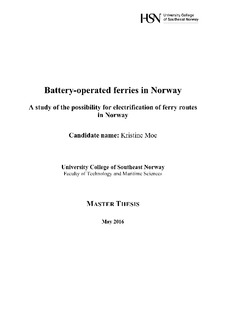Battery-operated ferries in Norway. A study of the possibility for electrification of ferry routes in Norway
Master thesis
Permanent lenke
http://hdl.handle.net/11250/2459431Utgivelsesdato
2016Metadata
Vis full innførselSamlinger
Sammendrag
The world’s first all-electric car ferry “Ampere” has been operating the ferry route
Lavik – Oppedal as one of three ferries in over a year. The ferry was introduced as a start of a
revolution of green shipping in Norway. The Norwegian Government’s goal for climate
changes is to have proximate zero emission from the transport sector within 2050. This goal
must be halfway reached by 2030. Ferry routes, which are an important part of the Norwegian
transport, are the largest contributors for the emission from ships in Norway.
This thesis consists mostly of an analysis of a selection of ferry routes that are
adequate for electrification based on 4 criteria’s; length of the route, complexity, weatherexposure
and traffic basis. The power requirement for an all-electrical ferry is estimated for
ferries with a service speed of 12 knots and a capacity of 120 cars. For ferry routes that have a
passage time of more than 30 minutes hybrid solutions must be considered. The power grid
on each quay needs to be upgraded to be able to supply sufficient power. 12% of the ferry
routes already have the necessary available effect, but the majority of the routes that are
adequate for electrification have a need for reconstruction that will cost between 5 and 20
million NOK.
